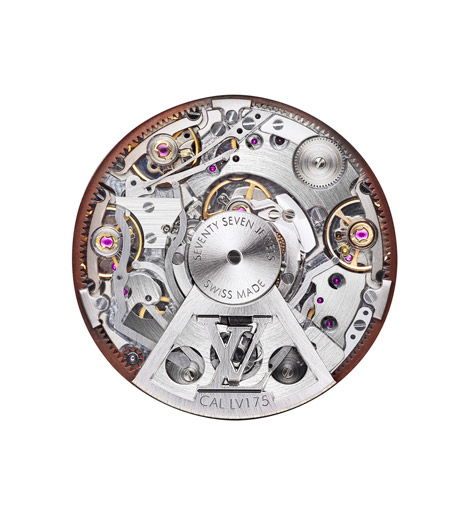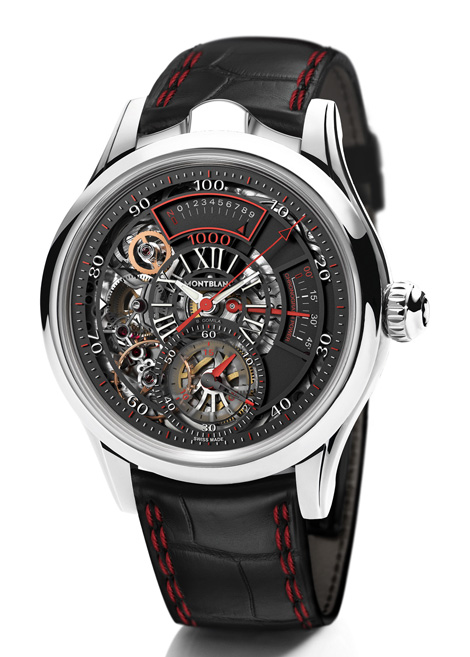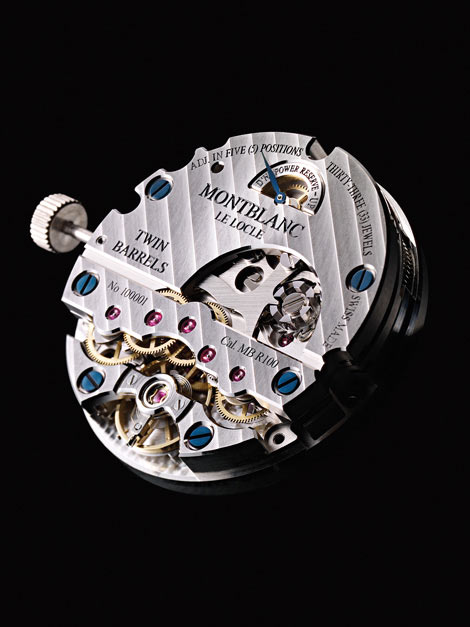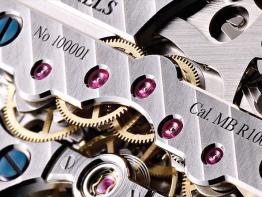Louis Vuitton and Montblanc watches: Meet two very unusual examples of the popular chronograph function controlled by a traditional column wheel.
Louis Vuitton Tambour Twin Chrono
At Baselworld this year, Louis Vuitton surprised the watch world with a unique chronograph: its never-before-seen function needed two column wheels to make it work, including one that boasts a different geometry than the classic column wheel. This patented world premier is not complicated for the sake of being complicated; it needs these integral chronograph components (and a host of others, 437 parts total in the movement) to accomplish its unique function. It is the first mechanical chronograph – to be precise, the running movement showing the time display is automatic, while the chronograph is powered by a manually wound mechanism – to measure two separate times and show the difference between them on the dial.
 The column wheels are needed to integrate and “translate” the commands related to these timing functions. The first column wheel, which comprises traditional horological geometry, controls the minute hand. The second has a fully unique shape, and its three levels perform two functions: start/stop of both “timers” and resetting the chronograph seconds. In principle, the Twin Chrono re-conceives the split-seconds chronograph and makes it doubly functional. Particularly for timing Match Racing regattas, which was its inspiration.
The column wheels are needed to integrate and “translate” the commands related to these timing functions. The first column wheel, which comprises traditional horological geometry, controls the minute hand. The second has a fully unique shape, and its three levels perform two functions: start/stop of both “timers” and resetting the chronograph seconds. In principle, the Twin Chrono re-conceives the split-seconds chronograph and makes it doubly functional. Particularly for timing Match Racing regattas, which was its inspiration.
 The column wheels are needed to integrate and “translate” the commands related to these timing functions. The first column wheel, which comprises traditional horological geometry, controls the minute hand. The second has a fully unique shape, and its three levels perform two functions: start/stop of both “timers” and resetting the chronograph seconds. In principle, the Twin Chrono re-conceives the split-seconds chronograph and makes it doubly functional. Particularly for timing Match Racing regattas, which was its inspiration.
The column wheels are needed to integrate and “translate” the commands related to these timing functions. The first column wheel, which comprises traditional horological geometry, controls the minute hand. The second has a fully unique shape, and its three levels perform two functions: start/stop of both “timers” and resetting the chronograph seconds. In principle, the Twin Chrono re-conceives the split-seconds chronograph and makes it doubly functional. Particularly for timing Match Racing regattas, which was its inspiration.
At this level of complication and finely finished elements including a grand feu enamel dial it’s no wonder that the Twin Chrono is limited to just 30 pieces.


Montblanc TimeWriter II Chronographe Bi-Fréquence 1000
Louis Vuitton’s CEO Hamdi Chatti was the former watch director of Montblanc, where he was instrumental in turning the purchase of Minerva into a highly interesting arm of Montblanc now called Villeret (after the town in which it is located). He was responsible for the unique, luxuriously and traditionally handcrafted timepieces, many based on existing Minerva calibers, that began churning out of the village factory in homeopathic – but gloriously traditional – doses. Indeed, it has taken a while for the collector community to acknowledge it, but the time has definitely arrived when one can do nothing other than admire the talent and determination in creating these beautiful products. The Nicolas Rieussec line is proof positive: beautiful finish combined with an unusually aesthetic design make this manually wound monopusher chronograph one to remember.
 The back of Caliber MB R100 and its derivatives are gorgeous with a plate covering half the movement, but cut out to reveal not only a power reserve indication, but also the traditional column wheel. Naturally, original Minerva base movements are still in use at Villeret too, meticulously finished with a vintage feel to them – and the obligatory swan-neck fine adjustment and column wheel that were typical of Minerva’s designs.
The back of Caliber MB R100 and its derivatives are gorgeous with a plate covering half the movement, but cut out to reveal not only a power reserve indication, but also the traditional column wheel. Naturally, original Minerva base movements are still in use at Villeret too, meticulously finished with a vintage feel to them – and the obligatory swan-neck fine adjustment and column wheel that were typical of Minerva’s designs.
 The back of Caliber MB R100 and its derivatives are gorgeous with a plate covering half the movement, but cut out to reveal not only a power reserve indication, but also the traditional column wheel. Naturally, original Minerva base movements are still in use at Villeret too, meticulously finished with a vintage feel to them – and the obligatory swan-neck fine adjustment and column wheel that were typical of Minerva’s designs.
The back of Caliber MB R100 and its derivatives are gorgeous with a plate covering half the movement, but cut out to reveal not only a power reserve indication, but also the traditional column wheel. Naturally, original Minerva base movements are still in use at Villeret too, meticulously finished with a vintage feel to them – and the obligatory swan-neck fine adjustment and column wheel that were typical of Minerva’s designs.
However, it is Montblanc’s TimeWriter II Chronographe Bi-Fréquence 1000 that deserves even more of our attention. This manually wound monopusher chronograph does more than take interval times; it takes the smallest possible time measurements – to the nearest 1/1,000th of a second. This is possible thanks to the fact that the manually wound chronograph has its own balance beating at 50 Hz. Though it seems highly unlikely, it is also possible to actually see this measurement as well thanks to the “dashboard” positioned at 12 o’clock.
 This particularly creative column-wheel chronograph is available only in a limited edition of 36 pieces. As an aside, this number was chosen as an homage to the year 1936, which is when Minerva was entered into the Guinness Book of World Records for a stopwatch able to take times to 1/100th of a second.
This particularly creative column-wheel chronograph is available only in a limited edition of 36 pieces. As an aside, this number was chosen as an homage to the year 1936, which is when Minerva was entered into the Guinness Book of World Records for a stopwatch able to take times to 1/100th of a second.

 This particularly creative column-wheel chronograph is available only in a limited edition of 36 pieces. As an aside, this number was chosen as an homage to the year 1936, which is when Minerva was entered into the Guinness Book of World Records for a stopwatch able to take times to 1/100th of a second.
This particularly creative column-wheel chronograph is available only in a limited edition of 36 pieces. As an aside, this number was chosen as an homage to the year 1936, which is when Minerva was entered into the Guinness Book of World Records for a stopwatch able to take times to 1/100th of a second. 
Featured brands








